Named after a British WWII fighter plane (as was a Kaiser Jeep four-cylinder), the Hurricane is a fully modern 3.0 liter six-cylinder powerhouse based on the four-cylinder 2.0 liter GME engine unofficially dubbed Tornado—another fighter plane and classic Jeep engine name.
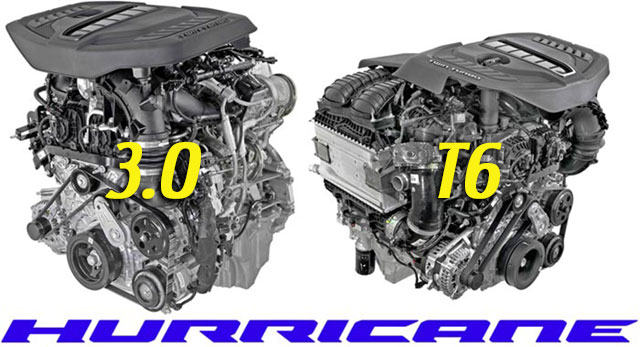
The engine was developed for North American-based vehicles—mainly Ram, Jeep, and Dodge—and has two versions, both with twin turbochargers. Maserati is largely relying on Ferrari for its engines, including a 90° V6, and at this point doesn’t seem to have a Hurricane in the works.
There are two variants of the engine, standard and high output, with a rumored higher-performance version likely awaiting the next-generation Dodge Charger.
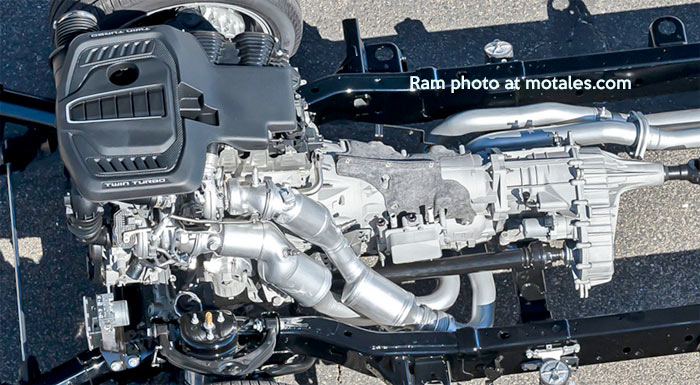
90% of peak torque is delivered from 2,350 rpm all the way up to redline (at least 405 pound-feet of torque by 2,350 rpm). Each of the twin turbochargers feeds three cylinders, and are responsive low-inertia, high-flow designs; the charge air cooler (“intercooler”) is a water-to-air deseign with a dedicated cooling circuit. Power ratings below are from the 2024 Wagoneer and Grand Wagoneer and 2025 Ram 1500; the latter gets an extra 30 hp.
| Hurricane SST | Standard | High Output |
|---|---|---|
| Horsepower | 420 | 510-540* |
| Torque | 469 | 500-521* |
| Turbochargers | Twin | Twin |
| Fuel injection | One pump | Twin pumps |
| Intercooler water inlets | One inlet | Two inlets |
| Fuel | 87 octane | 91 octane |
| Compression | 10.4:1 | 9.4:1 |
| Redline | 5,800 rpm | 6,100 rpm |
| Weight | 430 lb | 441 lb |
| Dimensions | 33.4 x 28.7 x 32.7 | 33.9 x 29.0 x 33.4 |
| Oil | 0W20 (API SP) | 0W40 (API SP) |
| Peak boost | 22.4 | 26 |
| Note | *Higher number is for Ram |
* Used for EPA testing. Power ratings might or might not be for 89 octane.
The advantages over the outgoing 5.7 Hemi are clear—it has much more torque, some more horsepower, weighs less, and uses less fuel—and the fuel it uses is cheaper.
| 5.7 Hemi | Hurricane | |
|---|---|---|
| Displacement | 5.7 l | 3.0 l |
| EPA mpg* | 16/22 | 17/24 |
| Power | 395 hp | 420 hp |
| Torque | 410 lb-ft | 469 lb-ft |
| Fuel | 89 octane | 87 octane |
| Fuel name | Midgrade | Regular |
The Hurricane engine is a deep-skirt cast-aluminum block with a structural aluminum alloy oil pan. Hailed as the strongest Ram engine ever, it uses cross-bolted steel main bearing caps to contain the forged steel crankshaft and connecting rods. During manufacturing, the block is deck-plate honed to optimize the cylinder bore shape.
Common measurements / specifications between the two inline six-cylinder engines:
| Bore x Stroke | 3.31 x 3.54 |
|---|---|
| Volume | 183 cid (2.993 liters) |
| Peak boost | 22.4 psi / 26 |
| Oil | 7.5 qt (w/filter) |
| Coolant | 16.6 qt high 2.85 qt low* |
* The cooling system has a low temperature circuit for the charge air cooler, using an electric pump, and a high temperature circuit with a belt driven pump and low restriction ball-valve thermostat; the turbochargers use an electrically driven after-run pump.
The aluminum block and small displacement compared with the 5.7 and 392 Hemis cuts weight by 125 pounds. They share bore and cylinder spacing with the 2.0 liter GME.
The twin cam engine provides independent variable valve timing. For durability and heat resistance the exhaust valves are sodium filled. The engine has hydroformed tubular camshafts and roller finger followers with hydraulic lash followers. The block itself is a deep-skirt cast aluminum design with cross-bolted steel main bearing caps. The oil pan is die-cast in Wagoneer, but has a structural aluminum alloy oil pan in the Ram 1500. The aluminum alloy heads have a pent-roof design, with a forged and twisted steel crankshaft, forged steel connecting rods, and die-cast aluminum alloy pistons with DLC-coated pins. The standard output version has a cast iron top ring land insert. The firing order is 1-5-3-6-2-4.
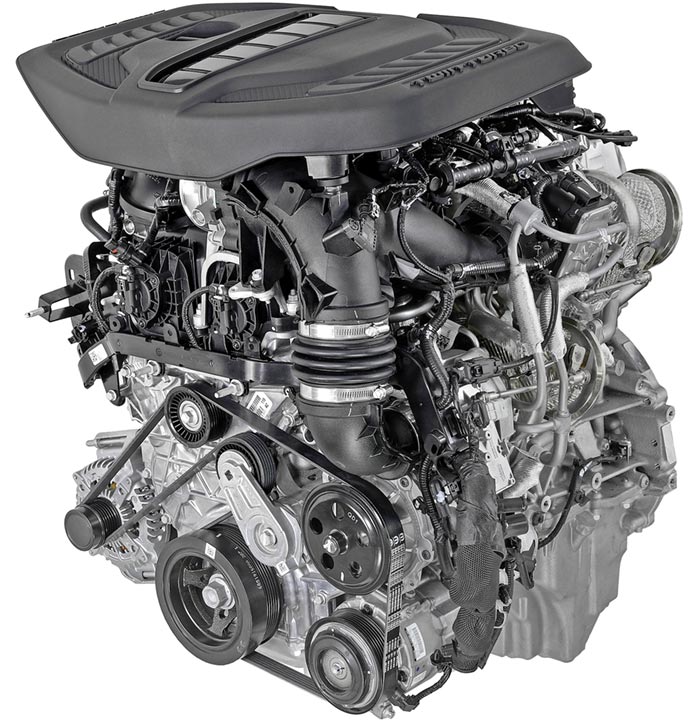
As predicted by Stellpower, Chrysler’s GMET6 3.0 liter engine will be produced by the Saltillo Engine Plant; this includes applying the cylinder hardening, using the PTWA process where a steel alloy wire is melted at 2,300°C (4,150°F) inside the cylinder. That sprays steel onto the walls at high velocity, bonding them to the aluminum; it is then honed for a fine cross-hatch pattern for oil retention. The result is more compact than iron liners.
Fuel pumps are chain-driven, from a dedicated shaft, and run at 350 bar (5,075 psi) with a single fuel rail.Mechanical losses are reduced with a high-flow ball-valve thermostat and a variable-displacement oil pump which tailors its output to demand. The chain-driven oil pump has a vane-type pressure stage and single georotor scavenge stage; the engine also has six pressure-activated piston cooling jets and an oil-to-coolant heat exchanger. Stop-start is standard.
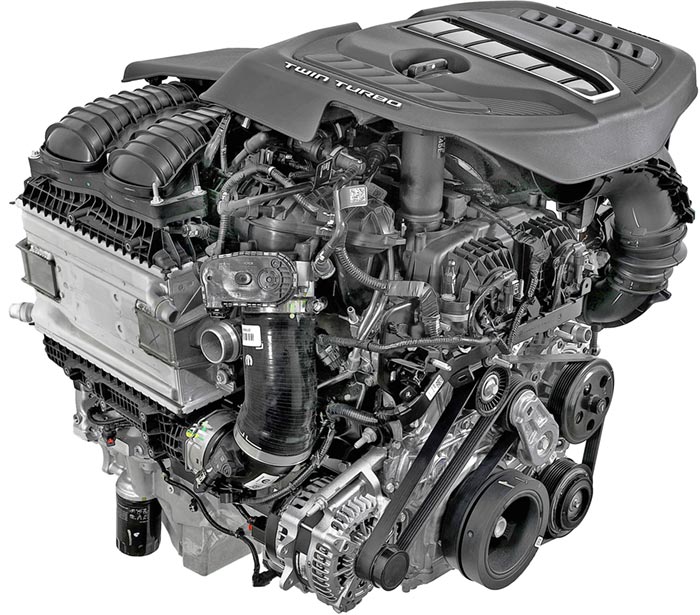
The high output version is optimized for performance and towing, pushing out 510 horsepower with 500 pound-feet of torque (540 hp and 521 lb-ft in the Ram 1500) compared with the heavier “392” V8’s 485 horsepower and 475 pound-feet of torque. Both the 392 and high-output Hurricane require 91-octane premium fuel.
The first Hurricane engines will be sold this year; production has already begun.
See the modern Tornado Four — officially, the GME T4.
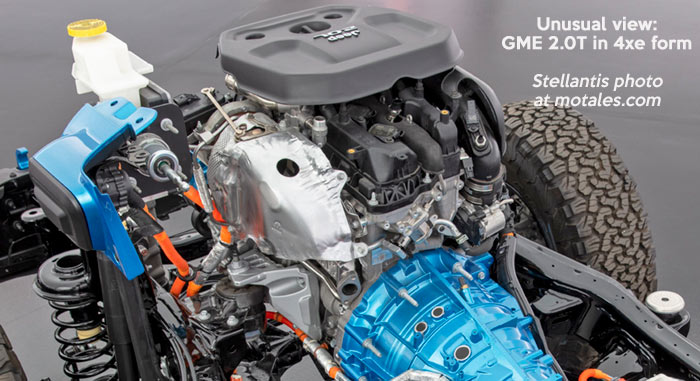
The fine book Jeep Wagoneer, Gladiator, Comanche, and Scrambler: Jeep’s Go-Anywhere Vehicles tells us that the original Hurricane Four was basically the old Willys Go-Devil engine used in Jeeps for quite some time, but fitted with an F-head to increase output to 72 horsepower and 114 pound-feet. The Go-Devil engine had been quite good for its time, but that time was pre-war, and it was starting to show its age; the Hurricane was needed for the higher expectations of the 1950s.
To use the Hurricane Four, Jeep had to raise the hood and grille of the CJ, creating the CJ-3B. Next, for 1954, Jeep launched its 115-horsepower “Super Hurricane” six-cylinder engine for trucks; this was an L-head in-line six-cylinder.
MoTales has new and old stories of Mopars, Chrysler Corporation, FCA US, AMC, and such. Check out the menus at the top of the page to learn new things about how it all happened—and to see notes about current and vintage vehicles and engines.
Under the superlatives, minor changes for 2026 Alfa Romeo Tonale
Ram remains top truck of Texas
Copyright © 2021-2025 Zatz LLC • Chrysler / Mopar car stories and history.
YouTube • Editorial Guidelines • Videos
Tailfins Archive • MoTales on BlueSky